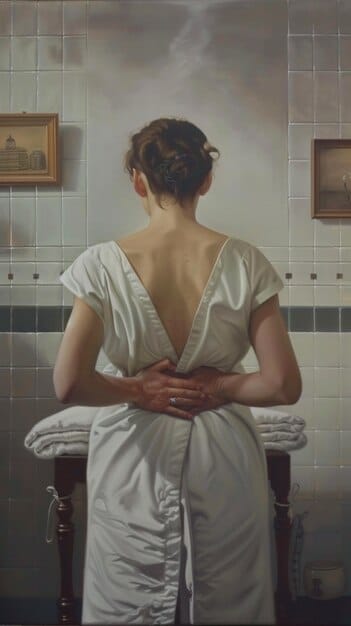Rediscovering the Artistic Brilliance of Vilhelm Hammershøi

Vilhelm Hammershøi, a Danish painter known for his serene and subdued interiors, is a master of atmosphere and light, creating hauntingly beautiful scenes of everyday life that often go unnoticed but hold profound artistic value.
Step into the quietly captivating world of **Vilhelm Hammershøi**, a Danish artist whose paintings, though not always widely recognized, offer a unique window into the beauty of simplicity and introspection.
Vilhelm Hammershøi: The Painter of Silence
Vilhelm Hammershøi (1864-1916) was a Danish painter celebrated for his distinctive and evocative interior scenes. His works often feature muted colors, subtle lighting, and a sense of serene stillness, capturing the essence of everyday life in a unique and profound way.
Hammershøi’s art stands apart due to its emphasis on atmosphere and mood rather than narrative. He invites viewers to contemplate the quiet beauty of ordinary spaces, finding depth in simplicity.
Early Life and Artistic Training
Born in Copenhagen, Vilhelm Hammershøi received formal training at the Royal Danish Academy of Fine Arts. His early works showed promise, but it was his departure from traditional academic styles that set him on a path to artistic distinction.
- Exploration of atmospheric effects in interiors.
- Rejection of overtly sentimental or dramatic subjects.
- Focus on technical precision and subtle color palettes.

Hammershøi’s early development was marked by a deliberate choice to eschew popular trends, paving the way for his unique artistic vision.
The Signature Style: Interiors and Light
Hammershøi’s most recognizable works are his interior scenes. These paintings often depict sparsely furnished rooms with a focus on the play of light and shadow. The rooms are usually devoid of people or feature figures seen from the back or in profile, adding to the sense of quiet mystery.
His use of muted colors, such as grays, whites, and browns, creates a calming and contemplative atmosphere. The architectural details of the rooms, like doorways, windows, and moldings, are rendered with meticulous precision.
The Significance of Light and Shadow
Light and shadow play a crucial role in Hammershøi’s interiors. He uses light to define the shapes and textures of the room, creating depth and dimension. The subtle gradations of light add to the sense of stillness and quiet contemplation.
The interplay of light and shadow emphasizes the feeling of solitude and introspection, inviting viewers to explore the emotional landscape of the painting.
Hammershøi had a clear vision of the space he intended to convey, and it is the skillful use of light that brings it all to life.
Hammershøi’s Mysterious Figures
While his interiors are often devoid of people, when figures do appear, they are usually presented in a way that adds to the overall sense of mystery. The figures are often turned away from the viewer, their faces obscured, or depicted in profile.
This lack of direct engagement with the viewer encourages introspection and invites speculation about the figure’s thoughts and emotions. The figures become part of the overall atmosphere of the painting, rather than the focal point.
- Figures often seen from the back or in profile.
- Ambiguous emotions and lack of direct engagement.
- Integration of figures into the overall atmosphere.

The placement and presentation of his figures highlight the overall sense of mystery and wonder in his work.
Influence and Contemporary Context
Hammershøi’s influence on later artists and movements is notable. His focus on interior spaces, subtle lighting, and muted colors has resonated with painters interested in atmosphere and mood. His work has been compared to that of Edward Hopper, known for his depictions of urban solitude.
In the contemporary context, Hammershøi’s paintings continue to captivate audiences with their serene beauty and timeless quality. His work appeals to those seeking a moment of quiet contemplation in a visually saturated world.
Hammershøi and Symbolism
Hammershøi’s art aligns with the Symbolist movement, which sought to convey subjective emotions and ideas through symbolic imagery. While not overtly symbolic, his paintings evoke a sense of mystery and introspection.
The ambiguity of his scenes invites viewers to project their own interpretations and emotions onto the artwork, aligning with the Symbolist emphasis on subjective experience.
- Evocation of mystery and introspection.
- Emphasis on atmosphere over narrative.
- Invitation for viewers to project their own interpretations.
Hammershøi’s style is unique to himself, but contains elements that give credence to the style of symbolism.
Modern Interpretations of Hammershøi’s Style
Hammershøi’s understated elegance and unique perspective continue to inspire contemporary artists. His visual language—characterized by muted palettes, geometric compositions, and enigmatic figures—has been reinterpreted across various media, from painting to photography.
One can observe Hammershøi’s impact in modern photography, where photographers mimic his use of soft, diffused light to create scenes that evoke introspection and stillness. Modern painters also borrow his color schemes to produce a sense of timelessness and quietude in their work.
Hammershøi’s Influence on Film
Film directors are often inspired by Hammershøi’s ability to create immersive atmospheres. His compositions have influenced film scenery and cinematography, where the play of light, shadow, and sparsely furnished spaces serves to build emotional depth.
The evocative nature of his interiors has been particularly effective in creating scenes that explore themes of isolation, memory, and inner psychological states.
Hammershøi’s influence can be seen in visual media, and it has had an undeniable impact on modern cinematography.
Preserving Hammershøi’s Legacy
Museums and art institutions worldwide are dedicated to preserving and showcasing Vilhelm Hammershøi’s art. Exhibitions of his work provide opportunities for audiences to engage with his paintings and understand his significance in art history.
Through ongoing research, conservation efforts, and educational programs, Hammershøi’s legacy is kept alive, ensuring that future generations can appreciate the beauty and depth of his artistic achievement.
- International exhibitions of his paintings.
- Research and conservation efforts.
- Educational programs to promote understanding.
Hammershøi’s timeless exploration of silence and solitude continues to inspire art enthusiasts, solidifying his status as a master of understated beauty.
| Key Aspect | Brief Description |
|---|---|
| 🎨 Muted Palette | Use of grays, whites, and browns to create a sense of calm. |
| 💡 Subtle Lighting | Focus on the interplay of light and shadow in interior spaces. |
| 👤 Enigmatic Figures | Figures often depicted from the back or in profile, adding mystery. |
| 🏠 Interior Focus | Emphasis on the quiet beauty and atmosphere of interior spaces. |
Frequently Asked Questions
▼
Hammershøi is best known for his interior scenes, showcasing sparsely furnished rooms, and his use of light and shadow to create atmosphere. Occasionally, he includes solitary figures, often with their backs turned.
▼
Hammershøi predominantly uses a muted color palette consisting of grays, whites, and browns. This subdued coloration contributes to the serene and contemplative mood of his works.
▼
Hammershøi’s unique style stands out due to his focus on atmosphere, subtle lighting, and sparse interiors. His art avoids overtly sentimental or dramatic subjects, emphasizing a quiet simplicity.
▼
Hammershøi’s focus on interior spaces and subtle lighting has influenced many artists, including Edward Hopper. His work continues to inspire those interested in creating mood and atmosphere in their art.
▼
Hammershøi’s paintings can be found in various museums and art institutions worldwide, particularly in Denmark, such as the National Gallery of Denmark in Copenhagen and other major galleries.
Conclusion
Vilhelm Hammershøi remains a celebrated figure in art history for his ability to transform simple, everyday scenes into profound visual experiences. His focus on light, atmosphere, and the quiet beauty of interior spaces continues to inspire and captivate audiences, ensuring his legacy endures as a master of understated elegance.





